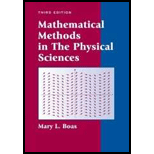
Concept explainers
The gamma function
Want to see the full answer?
Check out a sample textbook solution
Chapter 14 Solutions
Mathematical Methods in the Physical Sciences
Additional Math Textbook Solutions
Introductory Mathematics for Engineering Applications
A Problem Solving Approach to Mathematics for Elementary School Teachers (12th Edition)
Mathematics for Elementary Teachers with Activities (5th Edition)
Using & Understanding Mathematics: A Quantitative Reasoning Approach (7th Edition)
Mathematics with Applications In the Management, Natural, and Social Sciences (12th Edition)
- Algebra & Trigonometry with Analytic GeometryAlgebraISBN:9781133382119Author:SwokowskiPublisher:Cengage
